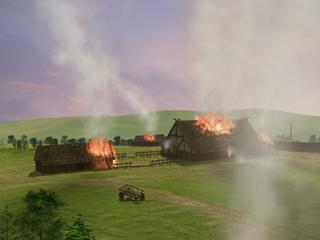| |

|
| |

|
You can find out more about:
|
|
|
Yeavering Saxon Royal Palace: Destruction of Yeavering
Clear archaeological evidence was found which showed that buildings were deliberately set alight at Yeavering and the
township destroyed. The excavator placed the timing of this event at around 633 when King Edwin was killed in battle
and massacres followed at the hands of Penda of Mercia and Cadwallon of Wales.
You can see what Hope-Taylor thought Ad Gefrin looked like before disaster struck.
But what was this evidence of disaster?
Many of the excavated building remains had scorch marks in the south west corner where fire appears to have been
deliberately started. In particular, the wooden theatre had scorch marks at the back of the structure consistent with
a heap of brushwood having been piled up against the standing timberwork and lit to start a fire. The fire appears to
have spread eastward in a south westerly wind. As the theatre had no hearth and was some distance from other
structures, it is highly unlikely that it could have started by accident. You can view a plan of the theatre (1038)
with the location of the scorch marks shown here. Every building was burned to nothing from south west to north east,
as the archaeologist Hope-Taylor said "�the disaster is surely to be seen as the result of a calculated act of
hostility." "Overall the evidence speaks of a desperate last stand by defenders loyal to all the township had stood
for�"
Yeavering went on to be rebuilt, but it never reached the heights of power that it once had. In time, the power base
of the Anglo-Saxon kings was moved eastwards to the Milfield Plain where another township was built, known as
Maelmin. This has never been excavated, but can clearly be seen in aerial photographs of the area, complete with a
Great Hall, just as Ad Gefrin once had.
|
|
|
 |